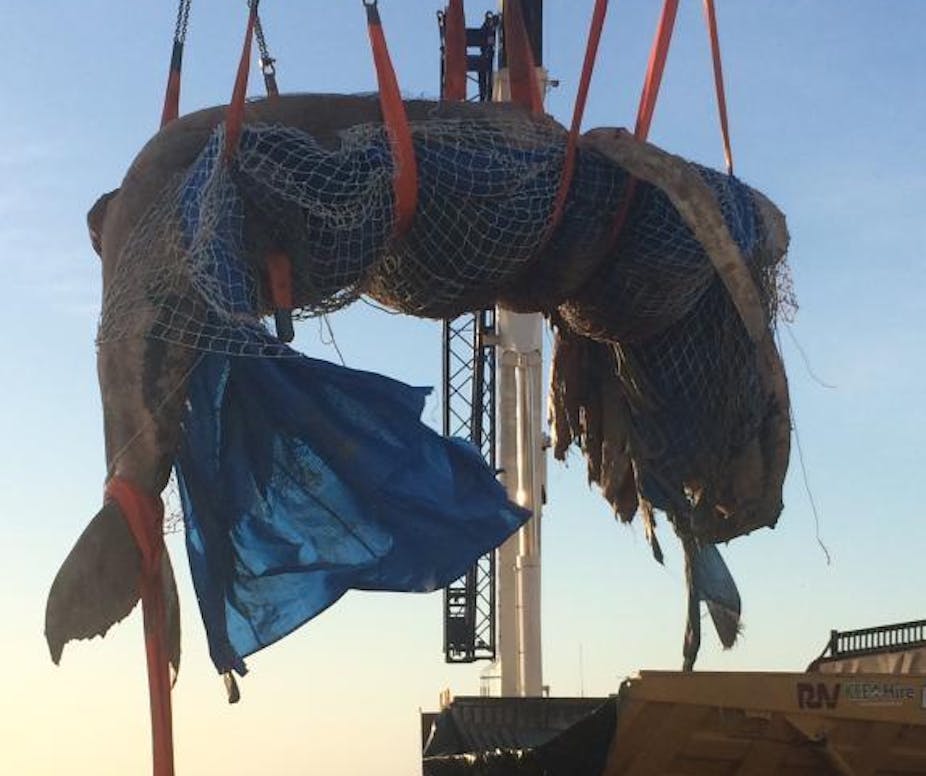A whale carcass can be a big headache – just ask the locals at Broulee Beach in southern New South Wales, where a dead whale washed back ashore last month despite already having been towed out to sea just after Christmas.
This month’s mass stranding of 200 pilot whales (140 of which died) on New Zealand’s South Island also highlights the enormous task – and costs – of dealing with the carcasses.
Decisions on how to deal with a carcass, and who is going to pay the bill, need to be made quickly. Should a whale carcass be left to float ashore, or towed out to sea where nature can take its course? Unfortunately, the decision is not as straightforward as it sounds, and is complicated by legal issues over who takes responsibility.
The wash-up
If a carcass floats ashore near a populated area, the onus generally falls on local councils to dispose of it – at great cost to ratepayers. The City of Stirling was reportedly left with a bill of A$188,000 to remove a humpback whale carcass from Perth’s Scarborough Beach last November.
Yet finding workable alternatives is an issue. In Western Australia, for example, the legal landscape is complex, which can delay decisions about disposal. If a whale is alive, it is the responsibility of the Department of Parks and Wildlife (DPaW) as protected fauna; but if it dies and the carcass drifts into a shipping channel or harbour, the job falls to the Department of Transport or the local port authority, respectively. If the carcass ends up in a marine park, DPaW takes the lead again; and if it washes up on a beach, it is the local council’s problem. WA is not unique – the situation is just as complicated in several other states.
This means that local councils have no say in what happens to a whale carcass until it lands on their beach, potentially paying a huge price for other agencies’ earlier decisions not to take action. Once beached, there are two basic options: bury it where it lies, or remove it to landfill. Neither is cheap or straightforward.
To tow or not to tow
Towing the carcass out to sea might therefore be seen as a better option, but it also comes with financial and practical issues (although it would be relatively easy to calculate and compare the cost of towing relative to land disposal).
Towing a floating whale carcass back out to sea involves cooperation between different agencies, who must work together rather than sticking rigidly to their separate jurisdictions as described above. Last November, for example, a dead whale drifting near Perth’s Cottesloe Beach was successfully towed away by the Fremantle Port Authority, with the support of several agencies.
A similar coordinated effort stopped a dead humpback from washing up near Ulladulla, NSW, in 2011, potentially saving Shoalhaven City Council a significant cleanup bill.
It sounds like a win for everyone concerned. But these operations are easier said than done, primarily because they tend to be fraught with issues over who can legally “take possession” of a whale carcass and tow it away.
All cetaceans (whales, dolphins and porpoises) are protected under the federal Environment Protection and Biodiversity Conservation Act, as well as by various pieces of state conservation legislation. In WA, for example, the Wildlife Conservation Act forbids the taking or possession of protected fauna, including migratory animals or their carcasses.
Legally towing a whale carcass out to sea thus requires a special licence, issued in the interests of safety, public health, or environmental management. Practical considerations mean that conditions would also need to be imposed on where and how the carcass can be towed, to make sure it does not end up in a shipping lane, for example, or somewhere where it is still likely to wash ashore.
Winning teamwork
Yet as complex as these issues are, they are clearly capable of being overcome. The main barrier seems to be jurisdictional. Although once a whale carcass comes ashore it becomes the problem of a local council, last year saw a couple of examples in which state environmental departments stepped in and took charge – removing a sperm whale’s head from a Perth beach and clearing a dead humpback calf from Stockton Beach, near Newcastle.
The issue of how to deal with whale carcasses is not going to go away. Recent indications are that seasonal whale numbers have increased dramatically along migration corridors since the end of commercial whaling, while death due to natural causes or boat strikes is also likely to increase.
A clear policy is needed, for the benefit of the public and the marine environment. It would appear that proactive collaboration between agencies is critical to avoid expensive beach clean-ups in the future.
It is not purely about saving money. Disposing of carcasses at sea also benefits the marine environment – entire ecosystems are built around whale carcasses, from the immediate surface feeders (sharks and seabirds) to “whale fall” for seafloor animals.
In contrast, if a carcass floats ashore and is taken to landfill, it cannot provide this ecosystem service, and its only contributions are financial costs and a mess which negatively affects beachgoers.

